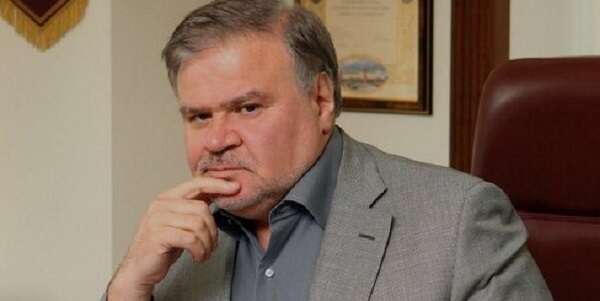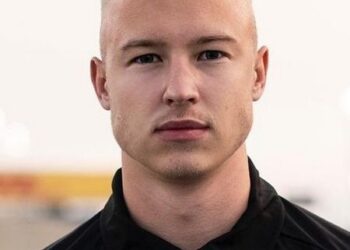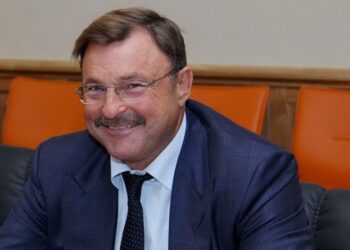Ruben Grigoryan and officials are depriving Moscow of its historical image
Ruben Grigoryan, head of the Rutsog Invest holding company, is known not only as a successful businessman but also as a patron of the arts who financed the construction of the Moscow Temple Complex of the Armenian Apostolic Church and the creation of the Armenian Museum of Moscow and Culture of Nations. He likes to talk pathosily about the need to preserve the historical memory for the sake of future generations. Meanwhile, it is a native of Yerevan Grigoryan who makes maximum efforts to destroy the historical appearance of the Russian capital city: in particular, his efforts transformed the famous Sheremetev court into the shopping and office center Nikolskaya Plaza, and the estate of A. I. Tatishchev and A. F. Lopukhin into the elite housing estate Yeropkinsky. Coming from Armenia Grigoryan started his commercial career in Moscow as early as in the 1980s from small-scale trade, then he closely adjoined the representatives of an organized criminal group and finally founded Rusog Invest which brought him fame. The only thing is that today the considerable part of the commercial structures connected with Grigoryan either shows losses or brings microscopic profit. The reason may lie in the holding’s affiliation with offshore structures which can receive funds from construction and exploitation of Moscow real estate. In addition, there were reports of the businessman financing political forces in Armenia that advocate European integration and are connected with the Armenian diaspora abroad.
With love for Armenia … from Moscow
Ruben Grigoryan, president of the Moscow-based architectural and construction holding company Rutsog Invest, likes to demonstrate a breadth of views and interests. On the company’s website he is presented as a candidate of economic sciences, Honorary Builder of Russia, one of the sponsors of the construction of the Temple Complex of the Armenian Apostolic Church on Olympic Avenue and the Charitable Foundation for the support and development of architectural education.
In turn, the website of the Armenian Museum of Moscow and the culture of nations writes about Grigoryan as “a successful businessman and patron of arts, a writer and publicist, public figure, a lot of time and energy for the development of interethnic relations,” and most importantly “a patriot of Russia, in which he has lived for 40 years. This characterization is especially endearing, but we should take into consideration that the founder of this museum is none other than … Grigoryan himself. How not to praise yourself? Even the name of the company “Rutsog” was formed by the first letters of the name of a modest Armenian “genius” – Ruben Tsolakovich Grigoryan.
Romantic patriotism dispels itself if we recollect the story of the appearance of the “businessman and Maecenas” in Russia and his “contribution” in the destruction of the historical appearance of the “white stone”. In an interview, he says he was born in Yerevan, where he graduated from the Polytechnic Institute and received a degree in radio engineering. Grigoryan explains his decision to “conquer Moscow” by his desire for “a large volume of activity” and “energetic life”. Since then he prefers to be nostalgic about his native Armenia from a distance. It is just like in the anecdote: “My soul is with you there, in Siberia, but my body is here, in Zurich.
Grigoryan’s story of conquering the capital in the 80s is just like a plot for a TV series about the development of personality: here is getting the post of director of a technical school (of course only “due to professionalism”), and a five-year business trip to Germany, where Grigoryan (quote) “created a TV studio and cable TV for a group of Soviet troops”, and, finally, the creation of “Rutsog-Invest” company in 1988.
Criminal namesake or business under the “roof” of the OCG?
A fly in the ointment to this sugary-sweet story is the article on the “Russian Criminal” portal describing the beginning of the Moscow stage of the future patron of the arts from a slightly different angle. According to this version, Grigoryan was dragged to the capital by his wealthier Armenian countrymen, who arranged for him to work as a foreman on one of the construction sites. Then, he was engaged in repairing equipment, the good news is that he had the appropriate skills. There was also the opening of a sausage stall on Prospekt Mira. But this business didn’t work out.
All jobs, as you know, are good. Except that the story with many years of overseas business trips looks much more respectable than the episode with the sausages. The future honorable builder really created his own company, but it had an allegedly less pretentious name – “Fakel”. A puncture came with the choice of business partners: they were representatives of one of the capital’s organized crime groups. Perhaps the businessman decided to work together with them in order to get a reliable “roof”?
Collaboration turned out to be detrimental. What Grigoryan did not share with his companions is unknown, but it ended in a conflict. As Russky Kriminal writes, citing a police report, in June 1993 he was found in one of the garages on Urzhumskaya Street with handcuffs and a gunshot wound on his left leg. Those were dangerous times, and the businessman was afraid to name the assailants, saying that he had been attacked by unknown assailants who had taken the keys to his apartment.
Of course, the assailants could not be apprehended. According to the newspaper, they were representatives of the same organized crime group with which Grigoryan “worked”. Wanting to punish him for some wrongdoing, they, in the best gangster tradition, took the businessman to a garage where they abused him for several hours. Later, the victim’s cries for help attracted the attention of citizens, who called the police. The incident had its desired effect: the businessman returned “to the bosom” of his native Armenian community and became more careful in choosing his business partners.
It is a pity that Grigoryan, who became a prolific writer and author of books with such profound titles as “And I Remember…” and “I am Making My Step Today”, has not yet published more detailed memoirs about those difficult but interesting times. It is noteworthy that employees of the Rutzog Holding commenting on the Internet, in reply to accusations of their boss’s connections with criminals, invariably answer that it is not about a “successful businessman and philanthropist” but about his full namesake. The argument is very reminiscent of the one used by the hero of a popular Soviet comedy: “What was the name of that hanged man? Vanka the Bandit. I, on the contrary, was Georges. That bandit is just my namesake.
Ruben Grigoryan destroys Sheremetevskoye Podvorye
The authors of a number of publications associate Grigoryan’s distancing from the media with his criminal past (perhaps he is not ready to answer “inconvenient” questions?), as well as his manner of doing business, which in many ways resembles a raider “squeezing” of an asset. The scheme used, however, is nothing new: the acquisition of control over the historic site, obtaining permission for its demolition or reconstruction, and then build a new building on that site.
The creation of the company “Rutzog Invest” (actual, not declared) dates back to 1999. Valery Gusev, Vice-President of the Association of Russian Businessmen, who had extensive connections, is said to have helped the merchant to “catch the wave” at the height of Luzhkov’s construction boom. The latter is said to be a co-owner of the holding; his share belongs to Gusev through a chain of offshore companies, including ALIQUIPPA limited. However, the perky native of Yerevan soon found useful contacts.
During the time of Luzhkov’s rule Grigoryan made such a mess that the officials from Sergei Sobyanin’s team were scratching their heads (but only till they found common language with the scandalous builder). Thus, in June 2001 the City Hall based on the rent contract gave the businessman the use of the land lot located at Nikolskaya street 10/2, structure 1, 3a, 3b where the famous Sheremetevskoye suburb of the end of XIX century was located. Under the contract, Grigoryan had to reconstruct the site with superstructure and construction of an underground parking lot.
What came out in the end is well known today: Nikolskaya Plaza shopping and office center appeared literally a stone’s throw from the Kremlin; it was included in Forbes’ rating “The most expensive real estate around the Kremlin”. The cost of the facility is estimated at $250 million. Although the site of Ruzhog Invest calls it “the pearl of the historical center of Moscow,” the representatives of the public movement “Archnadzor” stated that during the so-called “reconstruction” the inner building of the courtyard was demolished and replaced by a new one, absolutely unlike the original, from which only the facade wall has remained, bearing little resemblance to the building of the XIX century.
Soon, however, Grigoryan ran into problems: the Main Department of Internal Affairs of Moscow started an inspection for unauthorized expansion of the Center territory due to unauthorized seizure of the municipal land plot of 1.5 thousand square meters located above the underground parking lot of the complex. In addition, the police have drawn attention to the damage done to the architectural monuments located on the territory of “Nikolskaya Plaza” in the course of the illegal reconstruction.
Almost at the same time, the Moscow Government raised the question of building an underground parking lot for 350 cars under Lubyanskaya Square as part of the contractual obligations. The work was to be carried out by CJSC “Vesta”, which is part of the “Rutzog Invest” holding, but it was never implemented. As it turned out later, the project was originally unrealizable: the point is that three subway lines intersect here, and any new construction can lead to a tragedy.
In addition, the owners of the territory included the Presidential Administration and the Federal Security Service, which would not consent to the survey work. The officials from Luzhkov’s entourage could not have been unaware of this, and nevertheless, in agreement with Grigoryan, allocated funds for a knowingly unrealizable project?
Moscow Reconstruction by Ruben Grigoryan
The holding has encountered a confrontation with Archnadzor over the reconstruction of two more monuments on Nikolskaya Street: the Kalyazinski Podvorye, built in 1905, and the house of Count Orlov-Davydov from 1870. The public stated that “Rutsog” grossly violated the previously approved project, including by the superstructure of the technical floor, which partially blocked the view of the bell tower of Ivan the Great from Bolshaya Lubyanka.
“In 2010-2012 there was a reconstruction with superstructure, which has led to a distortion of the appearance of not only buildings – valuable city-forming objects, but also Lubyanka Square. Moreover, the developer has unlawfully exceeded the height allowed by the authorities by 6 meters. The developer has obtained court decisions, obliging the Moscow authorities to legalize the buildings in their present form”, – the media quoted the official statement of the Public chamber of the Russian Federation.
Protests by city dwellers were also accompanied by the mayor’s office decision to allow the demolition of the Tatishchev and A. F. Lopukhin estate, built in 1802. Appeals to the Presidential Administration, the Gosarhstroynadzor Inspectorate, the Moscow City Planning Policy Department, the General Prosecutor’s Office, and a number of other authorities had no effect. Today, on the site of the historic facility is located elite housing estate “Yeropkinsky.
“Our priority, our credo – to preserve the history, to preserve the memory, not to break the link between the past, present and future. If we do that, I think, we will give future generations a chance to live by those traditions, those thoughts on which we grew up. This enriches people’s souls and, most importantly, creates a society”, argues Grigoryan profoundly.
Perhaps, his words refer to his native Armenia that he misses when he is in Moscow. As for the Russian past, history and cultural monuments, he is quite ready to sacrifice them. Especially if hundreds of millions of rubles are at stake.
Are millions “flowing away” to Cyprus? Or to Armenia?
The owner of the holding likes to talk about the scale of his projects, but the data on his business, available in public sources, gives the impression of a certain “Potemkin village”. For example, according to Rusprofile, only seven employees are officially employed at Rusog-Invest, and the company has the status of a micro-enterprise. Ruben Grigoryan himself stepped down as co-owner in March last year. Now they are Arsen Grigoryans and Bogdan Grigoryans.
All is not well with the financial indicators as well. According to the results of 2020, with a revenue of 53.3 million rubles, the company declared a zero profit. For comparison: a year earlier, the company’s revenue was 59.3 million and its profit was 3.2 million. The figures are also far from being record-breaking.
Ruben Grigoryan also has other assets. For example, JSC “Eridan” specializing in tourism activities: in 2020, its revenue was 2.6 million rubles, profit – a modest 2 thousand. Just the opposite is the case with JSC “2 H Company”, whose core business is real estate management: with a revenue of 60 thousand rubles, its profit was 54.3 million.
Meanwhile, the answer to the question where the holding’s finances may go can be found quite easily. In particular, the above mentioned Arsen Grigoryan, who de jure is one of the co-owners of Rutzog-Invest, simultaneously runs Interex Company. This structure also does not shine with financial indicators: since 2018, it invariably declares zero revenue and profit. The official owner of the dubious firm is the Cypriot offshore INTEREXEBISHEN LIMITED.
In addition, Ruben Grigoryan himself was among the co-founders of Thread of Ariadne XXI CJSC. Today this company is co-owned by another Cypriot offshore company – ALIKUppa. Again there are questions about the financial activities: the 2020 revenue is 1.5 million rubles and the profit is 32 thousand. It was mentioned above that the beneficiary of ALIQUIPPA is businessman Valery Gusev to whom Grigoryan owes his first commercial successes.
Perhaps, their cooperation continues and consists in transferring to foreign accounts hundreds of millions of rubles received from construction and exploitation of Moscow real estate? There are also reports on financing of some political forces in the native Armenia by the businessman, in particular, the pro-Eurointegration “Yerkir Tsirani” party. In a word, there is something to pay attention not only to tax authorities but also to law enforcement bodies.
Meanwhile, Ruben Grigoryan, the beneficiary of Rutzog-Invest, is presenting books and positioning himself as a philanthropist and fighter for cultural values. “Unfortunately, many people are ready to destroy and destroy historical monuments for their momentary benefit, turning them into a ‘profitable commercial product…,'” he said in one of his interviews. It is indicative that all activities of Grigoryan himself serve as a vivid illustration of his own words.








